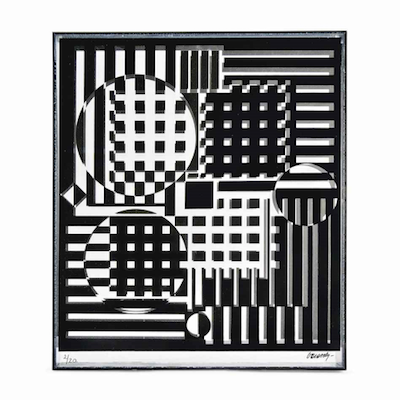
Details
Artist
Styles
Screenprint in colors on wove paper - Signed and numbered in pencil // Babel 3 by Victor Vasarely is a 1978 limited edition screen-print on wove paper. The composition presents a complex geometric labyrinth of colorful cubes arranged within a hexagonal frame. The vibrant palette includes a wide range of colors—reds, greens, blues, yellows—creating a three-dimensional illusion of interlocking paths. The piece exemplifies Vasarely's exploration of optical art, where the arrangement of shapes and colors plays with the viewer’s perception, challenging their sense of space and depth. The screen-print is hand-signed and numbered in pencil by the artist, capturing the vibrant essence of the Op Art movement.
Babel 3, 1978
form
Medium
Size
83.2 x 65.3 cm
- Inches
- Centimeters
Edition
Price
- USD
- EUR
- GBP
Details
Artist
Styles
Screenprint in colors on wove paper - Signed and numbered in pencil // Babel 3 by Victor Vasarely is a 1978 limited edition screen-print on wove paper. The composition presents a complex geometric labyrinth of colorful cubes arranged within a hexagonal frame. The vibrant palette includes a wide range of colors—reds, greens, blues, yellows—creating a three-dimensional illusion of interlocking paths. The piece exemplifies Vasarely's exploration of optical art, where the arrangement of shapes and colors plays with the viewer’s perception, challenging their sense of space and depth. The screen-print is hand-signed and numbered in pencil by the artist, capturing the vibrant essence of the Op Art movement.
- Recently Added
- Price (low-high )
- Price (high-low )
- Year (low-high )
- Year (high-low )
What is Op Art?
Op Art is a visual art style that uses optical illusions to create the impression of movement, vibrating patterns, flashing, or hidden images. The works are typically abstract, with many well-known pieces in black and white. The roots of Op Art can be traced back to earlier movements like Futurism, Constructivism, Dada, and Neo-Impressionism, particularly in their use of color effects and graphic design.






































































